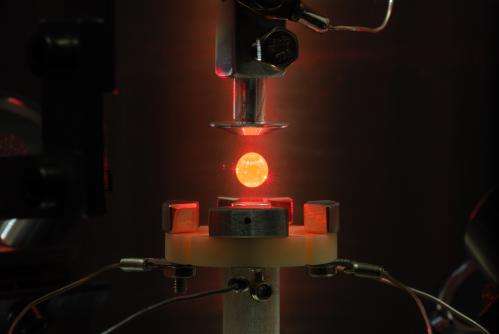Scientists reveal structure of a supercooled liquid

If a liquid metal alloy is cooled slowly it will eventually form a solid phase. Before it solidifies, however, the liquid undergoes a liquid-liquid transition to a phase in which it has the same concentration but a more strongly ordered structure. This structure has now been demonstrated for the first time by material scientists from Saarland University in a collaborative project with the German Aerospace Centre and the Leibniz Centre for Solid State and Materials Research in Dresden.
The experimental work, which was performed at the German Electron Synchrotron Facility (DESY) in Hamburg, involved levitating hot metal droplets and observing them as they cooled by irradiating them with x-rays from one of the world's strongest x-ray sources. The research work is funded by the German Research Foundation (DFG) and the results have just been published in Nature Communications.
Supercooled liquids demonstrate some interesting phenomena when they are irradiated with an extremely bright x-ray source. Shuai Wei, a doctoral student in the Metallic Materials Group headed by Professor Ralf Busch at Saarland University, has been able to observe such phenomena together with research colleagues from DLR are IFW. 'We have been able to show for the first time that a liquid that is being cooled transforms into a liquid of the same concentration but of greater order, before further cooling initiates crystallisation,' said Shuai Wei, who graduated with a Bachelor's degree in physics in Shanghai and has completed his Master's thesis under the supervision of Professor Busch. Busch and his team are particularly interested in liquid metals that, when cooled, eventually freeze to form bulk metallic glasses. As structural materials, these amorphous metals exhibit some very interesting properties.
In order to study the 'liquid-liquid transition' in metals in detail, the scientists made use of the experimental facilities at the large-scale research facility DESY in Hamburg to create positively charged metal droplets about 2 to 3 millimetres in diameter. These droplets were then levitated in vacuum between two electrodes. Shuai Wei explained the advantage of this type of electrostatic levitation: 'When the droplet is suspended in an electric field, it has no contact with its environment, so no crystal nucleation can occur and the process of crystallisation is slowed down.' The suspended droplets were then cooled by several hundreds of Kelvin during which time they were illuminated with particularly intense x-rays from the 'Doris III' synchrotron beamline at DESY. 'Each image was completed within one second – in a "normal" x-ray device, the image would have taken several hours to record,' explained Ralf Busch. 'This allowed us to continuously monitor the cooling process and we detected phenomena within the metal droplets that would otherwise have been invisible. For instance, we observed that their structure exhibits an increasing degree of order although the density of the material remains constant.'
Shuai Wei added that earlier work had already indicated that the viscosity and energy content of the liquid also change during the cooling process. He summarized the findings of his research work as follows: 'By demonstrating this structural modification, we have been able to show that within the liquid phase a 'fragile' less-ordered liquid is transformed into a so-called 'strong' liquid with a higher degree of order.' These processes were detectable at temperatures in the range 1200 K (927 °C) to 800 K (527 °C).
'The results help to provide us with a better understanding of how a material reorganizes when it undergoes cooling,' said Shuai Wei. The special properties associated with metallic glasses may enable the creation of higher performance materials. The young research scientist is already carrying out further experiments at the synchrotron facility's new 'Petra III" beamline, which according to DESY is the world's biggest and most brilliant storage ring x-ray source.
More information: DOI: 10.1038/ncomms3083
Journal information: Nature Communications
Provided by Saarland University














.jpg)





